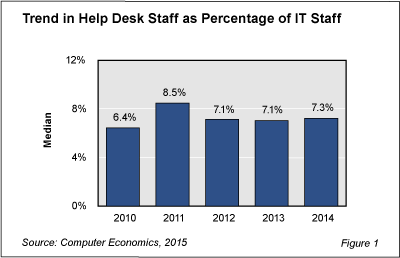Over the past three years, help desk staffing levels have remained largely unchanged as a percentage of the IT staff, reaching an apparent equilibrium point after a period of fluctuation.
Figure 1 from our study, Help Desk Staffing Ratios, shows that help desk personnel made up 7.3% of the typical IT staff at the median in 2014, which is about the same as the 7.1% level in 2012 and 2013. This stands in contrast to the relatively sharp fluctuation in the basic staffing ratio during the initial stage of the recovery, when in ranged from a low of 6.4% in 2010 to a high of 8.5% in 2011. It appears IT organizations brought the help desk staff back to full strength early in the recovery cycle, where it has remained.

The annual fluctuation in help desk staffing also reflects relative changes in the overall staffing mix. Other positions could be growing or shrinking, making the help desk staff appear smaller or larger as a percentage of the total. The staffing mix change accounts for at least some of the fluctuation during the recovery period.
In our study, we define help desk staff as personnel who provide first-contact support to end users, typically by phone, email, or chat. The category does not include desktop support personnel or subject-area experts such as network management, systems management, or application programmers who reside in other functional groups but may respond to escalations from the help desk. Nor does the help desk staff headcount include managers or trainers. They are in separate categories.
Because the help desk comprises a sizable portion of the IT staff, it can be a target for outsourcing and efficiency gains through improved processes and automation tools. Yet as organizations absorb more applications and technology, including smartphones and other mobile devices, they also can find a need to expand the help desk function. Moreover, enhancing the help desk function can lead to economies of scale in other technical support functions.
As such, help desk staffing levels require ongoing assessment. An overstaffed help desk can be a drain on the IT budget, while an understaffed operation can sap an organization’s productivity and create dissatisfaction among users. Benchmarking against industry standards is an important starting point for determining whether a help desk is appropriately organized for delivering quality service at the lowest possible cost.
The full study provides metrics for benchmarking help desk staffing levels in the current environment. We look at the trend in help desk staffing and provide two benchmarks by organization size: help desk staff as a percentage of the IT staff and users per help desk staff member. Because companies organize the end-user support function in different ways, we also provide benchmarks for a combined help desk and desktop support staff. We conclude with recommendations on optimizing help desk staffing levels.
This Research Byte is a brief overview of our report on this subject, Help Desk Staffing Ratios. The full report is available at no charge for Computer Economics clients, or it may be purchased by non-clients directly from our website (click for pricing).
Do you also need staffing ratios for other IT job functions? Consider this collection of all of our staffing ratio reports, which bundles them all into a single report at a significant discount: IT Staffing Ratios–Special Report Bundle.

